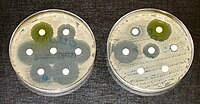
Photo from wikipedia
Targeting lanosterol 14α-demethylase (LDM) with azole drugs provides prophylaxis and treatments for superficial and disseminated fungal infections, but cure rates are modest for immunocompromised patients and individuals with comorbidities. The… Click to show full abstract
Targeting lanosterol 14α-demethylase (LDM) with azole drugs provides prophylaxis and treatments for superficial and disseminated fungal infections, but cure rates are modest for immunocompromised patients and individuals with comorbidities. The efficacy of azole drugs has also been reduced due to the emergence of drug-resistant fungal pathogens. ABSTRACT Targeting lanosterol 14α-demethylase (LDM) with azole drugs provides prophylaxis and treatments for superficial and disseminated fungal infections, but cure rates are modest for immunocompromised patients and individuals with comorbidities. The efficacy of azole drugs has also been reduced due to the emergence of drug-resistant fungal pathogens. We have addressed these problems by expressing in Saccharomyces cerevisiae functional, hexahistidine-tagged, full-length Candida albicans LDM (CaLDM6×His) and Candida glabrata LDM (CgLDM6×His) for drug discovery purposes and determining their X-ray crystal structures. Compared with S. cerevisiae overexpressing LDM6×His (ScLDM6×His), the reduced susceptibility of CgLDM6×His to all azole drugs tested correlated with its level of overexpression. In contrast, the reduced susceptibility to short-tailed (fluconazole and voriconazole) but not medium-tailed (VT-1161) or long-tailed azoles (itraconazole and posaconazole) indicates CaLDM6×His works best when coexpressed with its cognate NADPH-cytochrome P450 reductase (CaNcp1A) rather than the host reductase (ScNcp1). Overexpression of LDM or Ncp1 modified the ergosterol content of yeast and affected growth inhibition by the polyene antibiotic amphotericin B. Affinity-purified recombinant Candida LDMs bind carbon monoxide and show tight type II binding of a range of azole drugs, including itraconazole, posaconazole, fluconazole, and voriconazole. This study provides a practical basis for the phenotype-, biochemistry-, and structure-directed discovery of novel antifungals that target LDMs of fungal pathogens.
Journal Title: Antimicrobial Agents and Chemotherapy
Year Published: 2018
Link to full text (if available)
Share on Social Media: Sign Up to like & get
recommendations!